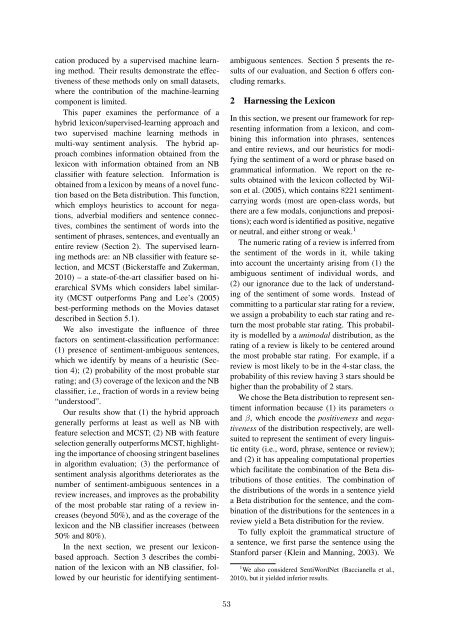Full proceedings volume - Australasian Language Technology ...
Full proceedings volume - Australasian Language Technology ...
Full proceedings volume - Australasian Language Technology ...
Create successful ePaper yourself
Turn your PDF publications into a flip-book with our unique Google optimized e-Paper software.
cation produced by a supervised machine learning<br />
method. Their results demonstrate the effectiveness<br />
of these methods only on small datasets,<br />
where the contribution of the machine-learning<br />
component is limited.<br />
This paper examines the performance of a<br />
hybrid lexicon/supervised-learning approach and<br />
two supervised machine learning methods in<br />
multi-way sentiment analysis. The hybrid approach<br />
combines information obtained from the<br />
lexicon with information obtained from an NB<br />
classifier with feature selection. Information is<br />
obtained from a lexicon by means of a novel function<br />
based on the Beta distribution. This function,<br />
which employs heuristics to account for negations,<br />
adverbial modifiers and sentence connectives,<br />
combines the sentiment of words into the<br />
sentiment of phrases, sentences, and eventually an<br />
entire review (Section 2). The supervised learning<br />
methods are: an NB classifier with feature selection,<br />
and MCST (Bickerstaffe and Zukerman,<br />
2010) – a state-of-the-art classifier based on hierarchical<br />
SVMs which considers label similarity<br />
(MCST outperforms Pang and Lee’s (2005)<br />
best-performing methods on the Movies dataset<br />
described in Section 5.1).<br />
We also investigate the influence of three<br />
factors on sentiment-classification performance:<br />
(1) presence of sentiment-ambiguous sentences,<br />
which we identify by means of a heuristic (Section<br />
4); (2) probability of the most probable star<br />
rating; and (3) coverage of the lexicon and the NB<br />
classifier, i.e., fraction of words in a review being<br />
“understood”.<br />
Our results show that (1) the hybrid approach<br />
generally performs at least as well as NB with<br />
feature selection and MCST; (2) NB with feature<br />
selection generally outperforms MCST, highlighting<br />
the importance of choosing stringent baselines<br />
in algorithm evaluation; (3) the performance of<br />
sentiment analysis algorithms deteriorates as the<br />
number of sentiment-ambiguous sentences in a<br />
review increases, and improves as the probability<br />
of the most probable star rating of a review increases<br />
(beyond 50%), and as the coverage of the<br />
lexicon and the NB classifier increases (between<br />
50% and 80%).<br />
In the next section, we present our lexiconbased<br />
approach. Section 3 describes the combination<br />
of the lexicon with an NB classifier, followed<br />
by our heuristic for identifying sentimentambiguous<br />
sentences. Section 5 presents the results<br />
of our evaluation, and Section 6 offers concluding<br />
remarks.<br />
2 Harnessing the Lexicon<br />
In this section, we present our framework for representing<br />
information from a lexicon, and combining<br />
this information into phrases, sentences<br />
and entire reviews, and our heuristics for modifying<br />
the sentiment of a word or phrase based on<br />
grammatical information. We report on the results<br />
obtained with the lexicon collected by Wilson<br />
et al. (2005), which contains 8221 sentimentcarrying<br />
words (most are open-class words, but<br />
there are a few modals, conjunctions and prepositions);<br />
each word is identified as positive, negative<br />
or neutral, and either strong or weak. 1<br />
The numeric rating of a review is inferred from<br />
the sentiment of the words in it, while taking<br />
into account the uncertainty arising from (1) the<br />
ambiguous sentiment of individual words, and<br />
(2) our ignorance due to the lack of understanding<br />
of the sentiment of some words. Instead of<br />
committing to a particular star rating for a review,<br />
we assign a probability to each star rating and return<br />
the most probable star rating. This probability<br />
is modelled by a unimodal distribution, as the<br />
rating of a review is likely to be centered around<br />
the most probable star rating. For example, if a<br />
review is most likely to be in the 4-star class, the<br />
probability of this review having 3 stars should be<br />
higher than the probability of 2 stars.<br />
We chose the Beta distribution to represent sentiment<br />
information because (1) its parameters α<br />
and β, which encode the positiveness and negativeness<br />
of the distribution respectively, are wellsuited<br />
to represent the sentiment of every linguistic<br />
entity (i.e., word, phrase, sentence or review);<br />
and (2) it has appealing computational properties<br />
which facilitate the combination of the Beta distributions<br />
of those entities. The combination of<br />
the distributions of the words in a sentence yield<br />
a Beta distribution for the sentence, and the combination<br />
of the distributions for the sentences in a<br />
review yield a Beta distribution for the review.<br />
To fully exploit the grammatical structure of<br />
a sentence, we first parse the sentence using the<br />
Stanford parser (Klein and Manning, 2003). We<br />
1 We also considered SentiWordNet (Baccianella et al.,<br />
2010), but it yielded inferior results.<br />
53














